 W
WGaelic Ireland was the Gaelic political and social order, and associated culture, that existed in Ireland from the prehistoric era until the early 17th century. Before the Norman invasion of 1169, Gaelic Ireland comprised the whole island. Thereafter, it comprised that part of the country not under foreign dominion at a given time. For most of its history, Gaelic Ireland was a "patchwork" hierarchy of territories ruled by a hierarchy of kings or chiefs, who were elected through tanistry. Warfare between these territories was common. Occasionally, a powerful ruler was acknowledged as High King of Ireland. Society was made up of clans and, like the rest of Europe, was structured hierarchically according to class. Throughout this period, the economy was mainly pastoral and money was generally not used. A Gaelic Irish style of dress, music, dance, sport, architecture, and art can be identified, with Irish art later merging with Anglo-Saxon styles to create Insular art.
 W
WThe early medieval history of Ireland, often called Early Christian Ireland, spans the 5th to 8th centuries, from the gradual emergence out of the protohistoric period to the beginning of the Viking Age. The period notably includes the Hiberno-Scottish mission of Christianised Ireland to regions of pagan Britain and the spread of Irish cultural influence to Continental Europe.
 W
WThe history of Ireland from 1169–1536 covers the period from the arrival of the Cambro-Normans to the reign of Henry II of England, who made his son, Prince John, Lord of Ireland. After the Norman invasions of 1169 and 1171, Ireland was under an alternating level of control from Norman lords and the King of England. Previously, Ireland had seen intermittent warfare between provincial kingdoms over the position of High King. This situation was transformed by intervention in these conflicts by Norman mercenaries and later the English crown. After their successful conquest of England, the Normans turned their attention to Ireland. Ireland was made a Lordship of the King of England and much of its land was seized by Norman barons. With time, Hiberno-Norman rule shrank to a territory known as the Pale, stretching from Dublin to Dundalk. The Hiberno-Norman lords elsewhere in the country became Gaelicised and integrated in Gaelic society.
 W
WThe Annals of Ulster are annals of medieval Ireland. The entries span the years from AD 431 to AD 1540. The entries up to AD 1489 were compiled in the late 15th century by the scribe Ruaidhrí Ó Luinín, under his patron Cathal Óg Mac Maghnusa, on the island of Senadh-Mic-Maghnusa, also known as Senad or Ballymacmanus Island, near Lisbellaw, on Lough Erne in the kingdom of Fir Manach (Fermanagh). Later entries were added by others.
 W
WThe Archdeacon of Kells, alias the Archdeacon of Nobber, was a medieval ecclesiastical post in the Diocese of Meath in the Kingdom of Meath, Ireland. The Archdeaconry was officially established sometime between the 11th and 13th centuries, and was annexed to the Rectory of Nobber. In the 16th Century, the office was briefly united to the Bishopric of Meath, but afterwards separated again. As a consequence of the Reformation, the Archbishop of Armagh held the "Archdeacony of Kells, in commendam 1569 to 1584". Sometime before 1622, the Archdeacon of Kells and Rectory of Nobber were permanently united to the bishopric of Meath.
 W
WIn Celtic cultures, a bard was a professional story teller, verse-maker, music composer, oral historian and genealogist, employed by a patron to commemorate one or more of the patron's ancestors and to praise the patron's own activities.
 W
WThe Book of Ballymote, was written in 1390 or 1391 in or near the town of Ballymote, now in County Sligo, but then in the tuath of Corann.
 W
WCeltic Christianity is a form of Christianity that was common, or held to be common, across the Celtic-speaking world during the Early Middle Ages. Some writers have described a distinct Celtic Church uniting the Celtic peoples and distinguishing them from adherents of the Roman Church, while others classify Celtic Christianity as a set of distinctive practices occurring in those areas. Varying scholars reject the former notion, but note that there were certain traditions and practices present in both the Irish and British churches that were not seen in the wider Christian world.
 W
WThe Celtic harp is a triangular frame harp traditional to Ireland and Scotland. It is known as cláirseach in Irish and clàrsach in Scottish Gaelic. In Ireland and Scotland, it was a wire-strung instrument requiring great skill and long practice to play, and was associated with the Gaelic ruling class. It appears on Irish and British coins and coat of arms of the Republic of Ireland, the United Kingdom and Canada.
 W
WA crannog is typically a partially or entirely artificial island, usually built in lakes and estuarine waters of Scotland, Wales, and Ireland. Unlike the prehistoric pile dwellings around the Alps, which were built on the shores and not inundated until later, crannogs were built in the water, thus forming artificial islands.
 W
WA cumdach or book shrine is an elaborate ornamented box or case used as a reliquary to enshrine books regarded as relics of the saints who had used them in Early Medieval Ireland. They are normally later than the book they contain, often by several centuries, typically the book comes from the heroic age of Irish monasticism before 800, and the surviving cumdachs date from after 1000, although it is clear the form dates from considerably earlier. Several were then considerably reworked in the Gothic period. The usual form is a design based on a cross on the main face, with use of large gems of rock crystal or other semi-precious stones, leaving the spaces between the arms of the cross for more varied decoration. Several were carried on a chain or cord, often suspended round the neck, which by placing them next to the heart was believed to bring spiritual and perhaps medical benefits. They were also used to witness contracts. Many had hereditary lay keepers from among the chiefly families who had formed links with monasteries. Most surviving examples are now in the National Museum of Ireland ("NMI").
 W
WThe Kingdom of East Breifne or Breifne O'Reilly was an historic kingdom of Ireland roughly corresponding to County Cavan that existed from 1256 to 1607. It took its present boundaries in 1579 when East Breifne was renamed Cavan, after Cavan town, and shired into Ulster. Originally part of the older Kingdom of Breifne, East Breifne came into existence following a protracted war between the ruling O'Rourke clan and the ascendant O'Reillys which culminated in the division of the kingdom in 1256. The Kingdom was ruled by the dynasty of the Ó Raghallaigh (O'Reilly) and lasted until the early 17th century.
 W
WFianna were small, semi-independent warrior bands in Irish mythology. They are featured in the stories of the Fenian Cycle, where they are led by Fionn mac Cumhaill. They are based on historical bands of aristocratic landless young men in early medieval Ireland.
 W
WIn medieval Irish myth, the Fir Bolg are the fourth group of people to settle in Ireland. They are descended from the Muintir Nemid, an earlier group who abandoned Ireland and went to different parts of Europe. Those who went to Greece became the Fir Bolg and eventually return to Ireland, after it had been uninhabited for many years. After ruling it for some time and dividing the island into provinces, they are overthrown by the invading Tuatha Dé Danann.
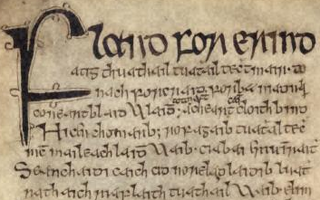 W
WThe (Great) Book of Lecan is a medieval Irish manuscript written between 1397 and 1418 in Castle Forbes, Lecan, in the territory of Tír Fhíacrach, near modern Enniscrone, County Sligo. It is in the possession of the Royal Irish Academy.
 W
WThe history of Ireland 800–1169 covers the period in the history of Ireland from the first Viking raids to the Norman invasion. The first two centuries of this period are characterised by Viking raids and the subsequent Norse settlements along the coast. Viking ports were established at Dublin, Wexford, Waterford, Cork and Limerick, which became the first large towns in Ireland.
 W
WWest Connacht was a kingdom of Gaelic Ireland, associated geographically with present-day County Galway, particularly the area known more commonly today as Connemara. The kingdom represented the core homeland of the Connachta's Uí Briúin Seóla kindred and although they ruled, there were smaller groups of other Gaels in the area, such as the Delbhna Tir Dha Locha and the Conmhaícne Mara. It existed from 1051 onwards, after the Ó Conchobhair, Kings of Connacht, pushed the Ó Flaithbheartaigh to the West of Lough Corrib, from their original territory of Maigh Seóla. Iar Connacht remained a subordinate túath of Connacht, until the 13th century, after which it was more independent.
 W
WInsular art, also known as Hiberno-Saxon art, was produced in the post-Roman history of Ireland and Britain. The term derives from insula, the Latin term for "island"; in this period Britain and Ireland shared a largely common style different from that of the rest of Europe. Art historians usually group insular art as part of the Migration Period art movement as well as Early Medieval Western art, and it is the combination of these two traditions that gives the style its special character.
 W
WThe High Kings of Ireland were sometimes historical and sometimes legendary figures who had, or who are claimed to have had, lordship over the whole of the island of Ireland.
 W
WThe Iverni were a people of early Ireland first mentioned in Ptolemy's 2nd century Geography as living in the extreme south-west of the island. He also locates a "city" called Ivernis in their territory, and observes that this settlement has the same name as the island as a whole, Ivernia. The name Iverni has been derived from Proto-Indo-European *PiHwerjoHn, "the fertile land". It was probably once the name given to all the peoples of Ireland, but by Ptolemy's time had a more restricted usage applicable to the inhabitants of the south-west. These Iverni can be identified linguistically with the Érainn, a people attested in Munster and elsewhere in the early Middle Ages.
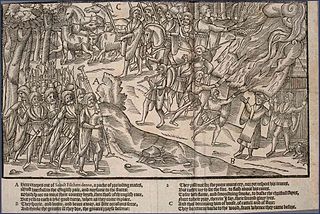 W
WA kern was a Gaelic warrior, specifically a light infantryman, in Ireland in the late Middle Ages.
 W
WA leacht is a small square or rectangular stone structure often found in Early Irish Christian places of worship. They are typically made from rough, unmortared stones, and are most often found in monasteries on island off the west coast of Ireland. Their precise function is unknown, they may have been erected to mark burial places, or to honor a saint, or for use as an altar or place of prayer.
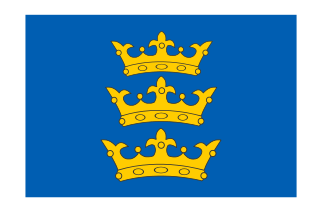 W
WThe Lordship of Ireland, sometimes referred to retroactively as Norman Ireland, was the part of Ireland ruled by the king of England and controlled by loyal Anglo-Norman lords between 1177 and 1542. The lordship was created as a papal fief following the Norman invasion of Ireland in 1169–1171. As the lord of Ireland was also the king of England, he was represented locally by a governor, variously known as justiciar, lieutenant, or lord deputy.
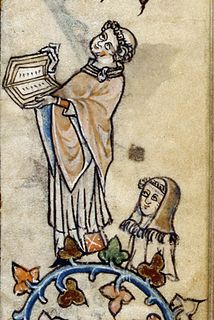 W
WManchan of Mohill,, was an early Christian saint credited with founding many early Christian churches in Ireland. His life is obscured because many people named Manchan are found among the monastically-inclined Medieval Irish Christians, and the name is a diminutive of Irish: Manach Latin: Monachus, a monk. Manchan probably died of famine during volcanic winters caused by the extreme weather events of 535–536, which preceded the 6th century Justinian plague of Mohill. The Shrine of Manchan is a remarkable and unique example of Irish Urnes style art, adapted to Ringerike style, skillful in design and execution. Saint Manchan's feast day is celebrated 14 February by Orthodox Catholics, Roman Catholics, and Anglicans.
 W
WThe Monastery of Ennisnag was an early Irish Christian monastery, and later a medieval prebendal church, located at Ennisnag, in County Kilkenny, Ireland. The medieval monastery and church are no longer extant. From the ruins, St Peter's church, of Protestant denomination, was established in the early 19th century.
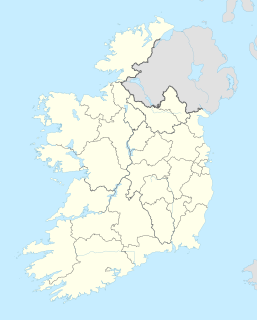 W
WThe monastery of Mohill-Manchan was anciently located at Mohill, in county Leitrim. The earliest church was founded by Manchán of Mohill in the 6th century. Little is known about the former monastic community here. About the year 1216, the monastery became a religious house of the Canons Regular of Saint Augustine dedicated to the Saint Mary until suppression c. 1550 – c. 1590. The Priory of Mohill was briefly revived during Confederate Ireland rule but suppressed again by Cromwellian forces c. 1649–1653. From the ruins St. Mary's Church, Mohill, of Protestant denomination, was established in the 18th century.
 W
WMonastic granges were outlying landholdings held by monasteries independent of the manorial system. The first granges were owned by the Cistercians and other orders followed. Wealthy monastic houses had many granges, most of which were largely agricultural providing food for the monastic community. A grange might be established adjacent to the monastery but others were established wherever it held lands, some at a considerable distance. Some granges were worked by lay-brothers belonging to the order, others by paid labourers.
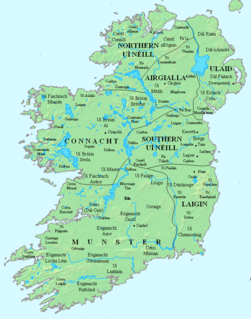 W
WMuintir Murchada was the name of an Irish territory which derived its name from the ruling dynasty, who were in turn a branch of the Uí Briúin. The name was derived from Murchadh mac Maenach, King of Uí Briúin Seóla, who died 891.
 W
WThe origins of the triangular frame harp are unclear. Triangular objects on the laps of seated figures appear in artwork of the Ireland, Scotland, England and Wales, as well as other parts of north-west Europe. This page outlines some of the scholarly controversies and disagreements on this subject.
 W
WThe origins of the Kingdom of Alba pertain to the origins of the Kingdom of Alba, or the Gaelic Kingdom of Scotland, either as a mythological event or a historical process, during the Early Middle Ages.
 W
WRanaghan is a townland and archaeological site in County Westmeath, Ireland.
 W
WSaighir, is a monastic site in Clareen, County Offaly, founded by St. Ciaran the Elder. The Irish state has officially recognized Saighir on the List of National Monuments in County Offaly.
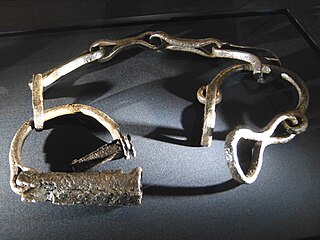 W
WSlavery had already existed in Ireland for centuries by the time the Vikings began to establish their coastal settlements, but it was under the Norse-Gael Kingdom of Dublin that it reached its peak, in the 11th century.
 W
WThe Tullycommon Bone (CIIC 52) is an archaeological find, discovered in 1934 during excavations of the fortification of Cahercommaun in the townland of Tullycommon, County Clare, Ireland. It is a complete metacarpal bone of a sheep with an Ogham inscription on each side. The find dates from the 7th to the 10th century.